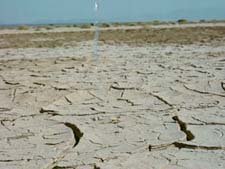Level 1 Drought Declared in 27 Counties in Western and Central Kentucky
0 views
Skip to first unread message
Pastor Dale Morgan
Sep 19, 2010, 2:11:45 AM9/19/10
to Bible-Pro...@googlegroups.com
 MUHLENBERG
COUNTY, KY - The Office of the State Climatologist and the Kentucky
Energy and Environment Cabinet, in coordination with the Kentucky
Drought Mitigation Team (KDMT), are issuing a Level I Drought
Declaration for five drought management areas (DMAs) in western and
central Kentucky. These five areas are in addition to the three
currently under the Level 1 declaration.
MUHLENBERG
COUNTY, KY - The Office of the State Climatologist and the Kentucky
Energy and Environment Cabinet, in coordination with the Kentucky
Drought Mitigation Team (KDMT), are issuing a Level I Drought
Declaration for five drought management areas (DMAs) in western and
central Kentucky. These five areas are in addition to the three
currently under the Level 1 declaration.Counties within the new Level I drought declaration areas:
Barren River DMA: Butler, Logan, Simpson
Lincoln Trail DMA: Breckinridge, Grayson, Hardin, Meade
KIDPA DMA: Bullitt, Henry, Jefferson, Oldham, Shelby, Spencer, Trimble
Northern Kentucky DMA: Boone, Campbell, Carroll, Gallatin, Grant, Kenton, Pendleton
Bluegrass: Anderson, Franklin, Harrison, Nicholas, Scott, Woodford
Counties already within the Level I drought declaration areas:
Purchase DMA: Fulton, Hickman, Carlisle, Ballard, McCracken, Graves, Marshall, Calloway
Pennyrile DMA: Livingston, Crittenden, Lyon, Caldwell, Hopkins, Trigg, Christian, Muhlenberg, Todd
Green River DMA: Union, Webster, Henderson, McLean, Daviess, Hancock, Ohio
Counties that are considered abnormally dry but not in the Level I drought declaration:
Bluegrass DMA: Bourbon, Boyle, Clark, Estill, Fayette, Garrard, Jessamine, Lincoln, Madison, Mercer, Powell
Buffalo Trace DMA: Bracken, Fleming, Lewis, Mason, Robertson
Gateway DMA: Bath Menifee, Montgomery, Morgan, Rowan
Lincoln Trail DMA: LaRue, Marion, Nelson, Washington
A Level I drought indicates moderate drought conditions have developed primarily affecting soil moisture and vegetative health. Serious impacts to agricultural water needs, wildfire risk and other water-sensitive sectors can be expected in the designated areas.
The current Level I Drought Declaration has been expanded eastward and northeast to cover areas that have widespread dryness throughout with precipitation totals of only 50 to 60 percent of normal for several consecutive months. Substantial rainfall from the remnants of a tropical storm fell across parts of the Commonwealth, including the drought-stricken Purchase and Pennyrile regions. This rainfall did help alleviate some of the drought impacts, but many still remain and will intensify without additional rainfall.
Many counties in the central part of the state that are not within the Level I Drought Declaration are developing drought-like conditions and impacts. These conditions are the result of the extremely high summer temperatures combined with the rapid change to a dry weather pattern over the past 30 to 60 days. If this pattern persists, it is expected that drought declarations will be declared for additional counties.
So far, the drought has primarily impacted agriculture. The dry conditions have resulted in an early harvest of corn and have substantially reduced corn and soybean yields. Pastures still recovering from previous years’ droughts have once again been negatively impacted, resulting in the early use of hay to feed livestock.
Many livestock water supplies have dried up and are forcing producers to rely on municipal suppliers, or water districts. These alternate sources result in higher costs for producers and increased demand on public water supplies. Urban landscaping has also been impacted resulting in the browning of lawns and the early loss of leaves on some trees.
Most of Kentucky’s potable water supply sources are currently at acceptable levels. Streamflows are generally low but within a normal range for September. Isolated areas of serious low flow have been observed in Salt River basins, including Rolling Fork in Nelson County; Pond Creek in Jefferson County; West Fork Drakes Creek in Simpson County; and Eagle Creek in Gallatin County.
Weather outlooks provided by the National Weather Service indicate that chances for widespread precipitation are slight for the widespread soaking rainfall events that are needed to alleviate the drought over the next 60 to 90 days. Isolated, spotty events with no real regional improvements in drought status are expected to continue. This will likely exacerbate the current impacts including an increased need for livestock water supplies, the selling off of livestock herds, difficulty planting winter wheat fields, and possible hay shortages. The forecast also suggests that the drought will spread into more of the central portions of Kentucky, affecting many water supplies that are drought vulnerable.
The state Drought Mitigation and Response Plan defines a tiered approach to classifying drought severity using multiple indicators to assess the intensity and location of developing drought. These indicators include the Drought Monitor, Palmer Drought Index, Crop Moisture Index, and precipitation and streamflow measurements.
More information about drought declaration criteria can be found in the Kentucky Drought Mitigation and Response Plan at http://water.ky.gov/wa/Documents/State%20Plan_Final.pdf
Persons involved in drought response will also find helpful a new guidance document about the effects of drought on public health recently published by the Centers for Disease Control. To obtain a copy of or for more information about When Every Drop Counts: Protecting Public Health During Drought Conditions—A Guide for Public Health Professionals, please send an e-mail to dro...@cdc.gov . An electronic version of the document is also downloadable from NCEH’s Web site at http://www.cdc.gov/nceh/ehs/Publications/Drought.htm.
Information Provided by Kentucky.Gov
Reply all
Reply to author
Forward
0 new messages
